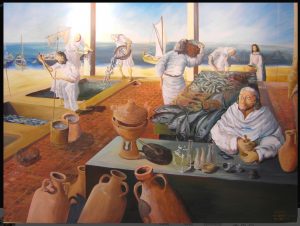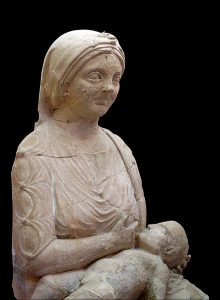After seven years of rough conditions, calmer waters have finally allowed archeological dive teams to locate underwater remains of a long-lost Roman city off the coast of current-day Tunisia, which was submerged by a tsunami over 1,600 years ago.
Mounir Fanter, the head of the Tunisian-Italian archaeological mission that made the find, told AFP News Agency, that the discovery of streets, monuments, mosaics, and nearly 100 tanks used to store garum, a fermented fish sauce sometimes called “Rome’s ketchup”, have allowed archaeologists to say that “Neapolis was a major center for the manufacture of garum and salt fish, probably the largest centre in the Roman world.”

Painting illustrating the Making of Garum, Neapolis Museum. By M.Rais (Own work) [Public domain], via Wikimedia Commons
The quest to find “Neapolis”, near the current day coastal town of Nabeul in Tunisia, has been on the Fanter team’s archeological radar for the last 10 years, but until this summer, ocean conditions have been too turbulent to allow dive teams any success. A combined project by the National Heritage Institute and the University of Sassari has sent divers to explore the 20-hectare (almost 50 acres) site – an area that was close to a third of the original city and the main area for trade of garum.
According to Bethan McKenan of the Independent, “Very little has been recorded about the city because the citizens of Neapolis sided with Carthage rather than Rome during the Third Punic War in 149–146 BC, which ultimately destroyed the rival civilisation and brought its territory under Roman control. There are so few references to Neapolis over an extended period of Roman literature, it is thought the city was punished for its allegiances.”
However the Romans may have viewed the allegiance of the coastal town of Neapolis, they couldn’t live without their ketchup equivalent – the fermented fish sauce called garum – the production of which contributed greatly to the wealth of the thriving port town.
Carol A. Dery, writing in Fish: Food from the Waters, The Proceedings of the Oxford Symposium on Food and Cookery 1997, Ed. Harlan Walker, Prospect Books 1998, on Fish as Food and Symbol in Ancient Rome, p 106, exhaustively details the many types of fish sauces used by the Romans. She provides the following quote from the 10th century on the making of garum:
“The most complete instructions for the production of garum are to be found in the Geoponica (20.46.1-6), a Greek agricultural manual, which dates from the tenth century AD:
- So-called liquamen is made in this manner: the intestines of fish are put into a vessel and sailed. Small fish, either the best smelt, or small red mullets, or sprats, or wolf-fish, or whatever is small, are salted together, and fermented in the sun. and frequently shaken.
- After it has been reduced in the heat, garum is obtained from it in this way: a large. strong basket is placed into the vessel containing the fish and the garum flows into the In this way the liquamen is strained through the basket when it is taken up. The remaining dregs are called alica.
- The Bythnians prepare it in this manner: it is best if you take small or large sprats, but if not, wolf-fish or horse-mackerel, or mackerel or even alica, or a mixture of all, and put these into a baker’s kneading trough, in which they customarily knead meal. Toss into the modius of fish two Italian sextarii of salt, and mix thoroughly in order to strengthen it with salt. After leaving it overnight, put it into a vessel and place without a lid in the sun for two or three months, stirring with a stick from time to time. Then cover and store.
- Some add two sextarii of old wine to one sextarius of fish.
- If you wish to use the garum straight away that is to say, not to ferment it in the sun, but to boil it, you do it thus: when the brine has been tested, so that an egg that has been put into floats (if it sinks, it is not sufficiently salty), put the fish into the brine in a newly-made earthenware pot, add some oregano, and place on a sufficient fire until it is boiled, and begins to reduce a little. Some also add defrutum (reduced wine-must). Then put the cooled liquid through a strainer two or three times until it turns clear. Then after covering it, store it away.
- The best garum, the so-called haimation, is made in this way: the intestines of
tunny along with the gills, juice, and blood are taken, and sufficient salt is sprinkled After leaving the vessel to stand for two months at the most, pierce the vessel, and the garum called haimation is withdrawn.”
See also, Andrew Smith’s From Garum to Ketchup, a Spicy Tale of Two Fish Sauces, also from Fish: Food from the Waters, The Proceedings of the Oxford Symposium on Food and Cookery, on the making, popularity, and usage of garum and other sauces.

Mother and child, Neapolis Museum, Tunisia, By M.Rais (Own work) [Public domain], via Wikimedia Commons.
 Garum mosaic from Pompeii, By Claus Ableiter (Own work) [CC BY-SA 3.0 (http://creativecommons.org/licenses/by-sa/3.0) or GFDL (http://www.gnu.org/copyleft/fdl.html)], via Wikimedia Commons
Garum mosaic from Pompeii, By Claus Ableiter (Own work) [CC BY-SA 3.0 (http://creativecommons.org/licenses/by-sa/3.0) or GFDL (http://www.gnu.org/copyleft/fdl.html)], via Wikimedia Commons 

